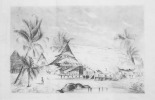[INDONESIE].
Village.
[Vers 1880]. Dessin original à la mine de plomb sur papier (env 24 x 16 cm).
Reference : LBW-6704
Beau dessin représentant un village situé en Indonésie, probablement dans la région du Kalimantan occidental, province située dans l'île de Bornéo. On y trouve ainsi représentées des maisons traditionnelles montées sur pilotis appellées Rumah Panjang (maison longue). Bon état de conservation.
Bookseller's contact details
Librairie Le Bail
Didier Le Bail
13 rue Frédéric Sauton
75005 Paris
France
33 01 43 29 72 59
Payment mode



5 book(s) with the same title
Archéologie du village déserté.
Paris, Armand Colin, 1970. 2 vol. in-4, broché pour le texte, en ff. sous chemise et étui d'édition pour l'atlas, 203 pp, 122 fig. en n/b. in t. (reprod. photogr., croquis, dessins, cartes...); [4]ff., 27 plans dépl., + les "bis" sur papier calque.
Cahiers des Annales 27. Ecole pratique des Hautes - Etudes et Académie Polonaise des sciences - VIe section. 4 Rapports de fouilles : 1- Dans l'Albigeois: le château et le village de Montaigut, 2- Sur le Lévezou: l'établissement médiéval de Saint-Jean-le-Froid, 3- Le village bourguignon de Dracy, 4 - Dans les baronnies: le village perché de Condorcet. Couv. un peu défraîchie, bon ex. - Frais de port : -France 6,9 € -U.E. 11 € -Monde (z B : 18 €) (z C : 31 €)
Epron Village de la Radio, pourquoi ? …
1989 Caen, Imprimerie Régionale, 1989, 1 Volume broché, 240 x 153 mm. 143 pp. Importante Iconographie N & B, dans et hors texte, 2 Envois, en pages de garde, non identifiés, bon exemplaire.
" Epron est le seul Pays en France portant ce nom. C'est surtout en 1948 qu'il devient célèbre. La Guerre, cette triste Guerre de 1939-1945, anéantit le Village, mais la Chance et la Solidarité ont fait d'Epron le Village de France reconstruit avant les autres. Ceci grâce à Francis Bernard et Jean Nohain."
Phone number : 02.31.77.03.74
Maître Robert de Sorbon et le village de Sorbon (Ardennes).
Reims, Impr. coopérative, 1888. In-8 broché, XII-82 pp., 2 planches (portrait et vue du village).
Etude parue à l'occasion de l'érection d'un monument en mémoire de R. de Sorbon dans son village natal. Débroché, couv. inf. défraîchie, int. correct, état convenable. - Frais de port : -France 4,95 € -U.E. 9 € -Monde (z B : 15 €) (z C : 25 €)
histoires de mon village - la mionette
paris alphonse taride libraire éditeur 1858 in 12 broché 163 pages
2eme édition augmentée de mon village - le village en question est saint-just-sur-loire dans la loire
Jacobins de Village - Un Bourg de Normandie pendant la Révolution
Rouen, Maugard, 1943, in-4 broché, 215 p., un des 230 ex. sur papier vergé de l'édition originale, 5 illustrations h.-t. de l'artiste qui mettent en valeur le patrimoine religieux du village d'Écouis qui possède une collégiale de dimensions imposantes fondée par Enguerrand de Marigny. L'intérieur de l'édifice renferme plusieurs statues remarquables. Préface de de Jean de La Varende : "Écouis, au centre de ses hautes plaines somptueuses, dominé par sa Collégiale qui semble, au milieu des cultures infinies, une île magique."
Plats tachés, cornés avec petite déchirure, coiffes tassées avec début de déchirure en queue ; intérieur très propre.
 Write to the booksellers
Write to the booksellers



